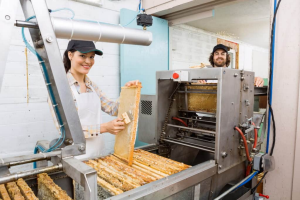|
 There are three businesses
you can run as a commercial beekeeper. There are three businesses
you can run as a commercial beekeeper.
1. You can take the classic approach and produce bee products for
either retail or wholesale markets. These would include (of course)
honey, beeswax products, pollen and propolis, as well as selling
packaged bees, queens and beekeeping supplies. Sasse's Apiary near
Chestnut is an example of this first classic approach.
2. A second approach would be to hire out your bees for regional
pollination for crops like pumpkins and fruit crops that are grown
here in central Illinois or as far away as California and Florida.
3. A third approach would be to breed and propagate bees and sell
them to other beekeepers.
A hybrid approach might be to combine two or three of these aspects
of commercial beekeeping, because different seasons seem to bring
different successes and failures.
Bees are considered livestock by the USDA and the agency regulates
beekeeping. A farmer entering this market must license his/her
apiary and it must be regularly inspected. The fees are minimal and
the inspections are easy to pass. Inspectors can help regulate bee
health and practices for best outcomes.

Honeybees providing pollination service in a pumpkin patch. [The
Valley Hive]
Keeping bees
requires significant investment in "wooden-ware" (hives), tools,
equipment and time. You can make your own hives, but often the
expense for wood is about the same as buying a pre-made hive.

In addition to the investment for hardware, keeping a stock of
healthy bees here in central Illinois, where we have real winters,
is also an ongoing struggle and expense. Our climate, along with
pests and hazards usually results in an average 40 percent survival
rate, so says Nathan Sasse of Sasse's Apiary.
In season, early spring to late fall, consistent attention can mean
the difference between success or total loss, start all over. Each
bee colony must be managed, with beekeeper inspections occurring
about once every two weeks at a minimum.
Costs correlate to size of operation, the bigger your operation, the
bigger the costs. Automation and handling equipment needs to grow as
your production and number of colonies increase.

Bees are curious creatures, always searching for food and seem to
need to know everything that is going on all the time. [The
University of Newcastle]
Honey bees are not domesticated: humans adapted themselves to the
honeybee, not the other way around. There is no genetic difference
between feral bees and hive-kept bees. Some colonies are docile, and
others are aggressive.

Honeybee aggression is measured in 1) what percentage of the colony
is comprised of guard bees, 2) how far will they chase you from the
hive, and 3) what does it take to trigger their aggressive response.
Most bee aggression is prompted by honeybees being killed. When they
are killed, they give off an alarm pheromone that prompts a
response.
A docile colony can also become aggressive when conditions are
stressful, their queen is dead, or their environment is out of
order.
Only female bees sting, and if they sting a mammal or a human with
thick skin, the bee loses its stinger and its life.

A team of beekeepers assessing winter losses in this commercial
apiary. [Wildflower
Meadows]
Most beekeepers wear appropriate protective suits, gloves and veils,
and getting stung is just part of the experience.
The sting is accompanied by bee venom, and people who are stung
suffer a variety of physical responses including pain, itching,
swelling and sometimes even anaphylactic shock, which can cause
collapse and even death. It is a good idea for a beekeeper to have
an EpiPen on hand. Some old seasoned beekeepers say that they don't
even feel it when they get stung, and it isn't unusual for a
beekeeper to get stung some twenty to 100 times a season even with
full bee suits and veils.
A beekeeper should be careful to balance the needs of the bees to
the available resources for best success. Colonies need to be placed
where they are protected from pesticide spraying, where there is
good access to water and sufficient flowers to provide nectar.
Nectar is what the bees make into honey.
[to top of second column] |

The commercial
pollination business, renting out bee filled hives, brings good
returns but often subjects bees to stresses and pesticides. Often
pollination colonies are given a vacation once their objective is
achieved so they can recover and reproduce.
Colonies are comprised of about 90% female bees that do all the
work. The average female worker bee lives about 45 days, and
progresses through a range of jobs from housekeeping to nursemaid,
then learns how to fly, serves as an undertaker, then as a guard
bee, and finally graduates at old age to foraging for food in about
a three-mile range.

The queen bee is the heart and soul of the beehive. She regulates
the colony by pheromones (smells), and is responsible for all
reproduction in a hive. The average queen lives for two or three
years, and can lay up to 2,000 eggs a day.
Though the colonies are female-centric, male bees (called drones)
are required for the reproductive process. During the summer drones
journey out daily to what is known as the "drone congregation area"
(DCA) to wait for virgin queens to arrive and after they inseminate
a virgin they fall to earth in death. The rest of the time they
lollygag around the hive asking for handouts, only to be killed and
thrown out of the hive in late September when they are no longer
needed.
Propagating bees is the act of creating queens, and beehives known
as Nucs (short for Nucleuses) for sale, having a deep understanding
of the cycles of colony life and reproduction. Nucs sell for as much
as $225 and are in high demand.
How much honey a colony can produce is dependent on the area of the
hive, how much rainfall and how well the individual colony does.
Each colony is unique. Colonies from the same genetics in the same
area will be different in production and characteristics. There is a
great demand for local honey, and local honey can have medicinal
effects as well as providing a sweet addition to food and drinks.
Sasse's Apiary produces local honey products and wholesales them
throughout central Illinois.
In addition to bee products, Sasse's sells packaged bees and queens,
taking orders in March and delivering in April of each year. They
can be reached at 217-615-8511 and on their website at
https://www.sassesapiary.com/

There are many books on the subject, and thousands of YouTube videos
that give excellent instruction. Belonging to a local beekeeping
association can be a valuable resource for information and
encouragement for a beginning beekeeper.
The first five years are a learning cycle for both the beekeeper and
the bees. Beekeeping is a business of feast or famine. Few who enter
this business quit early. Once it hooks you, you are usually hooked
for life.
Here are some YouTube videos to get you started:
Getting started -
https://www.youtube.
com/watch?v=9EIyS7To5Vw
Bob Binnie - commercial beekeeper
https://www.youtube.com/channel/UCD
yga7OtRJSzHzXXXurYCmQ/videos
Profit potential -
https://www.youtube.
com/watch?v=u4RufdP1Mco
Sell on Amazon? -
https://www.youtube.
com/watch?v=GOJA3HIUCUg

A sizeable operation uses automation and machinery to extract honey
from frames and bottle it for sale. [Beekeeper
facts]

|